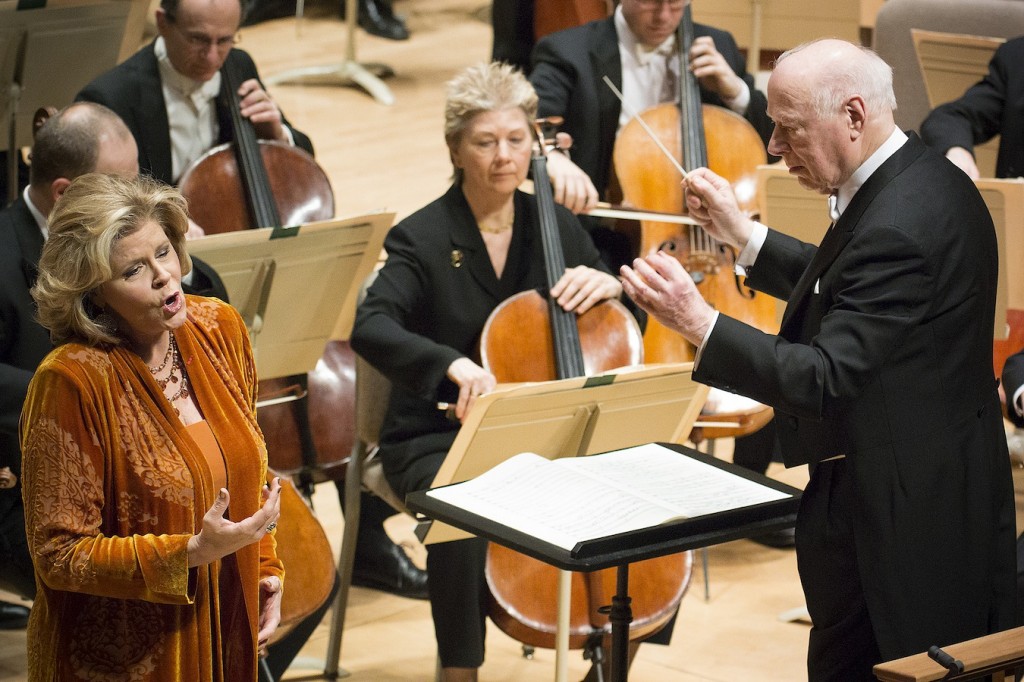Susan Graham enchants in BSO’s Ravel program

Susan Graham performed Ravel’s “Shéhérazade” Thursday night with Bernard Haitink and the Boston Symphony Orchestra. Photo: Stu Rosner
Thursday night’s all-Ravel program by the Boston Symphony Orchestra under Bernard Haitink was a curious kind of French repast: two delicate appetizers followed by an extravagant dessert. But while the multi-tiered gâteau of the complete ballet Daphnis et Chloé was the intended climax of the evening, it was the silky quenelles—the song cycle Shéhérazade, exquisitely rendered by mezzo-soprano Susan Graham—that lingered in the senses.
The meal began with sprigs of frisée, sprinkled with a few drops of sherry. Alborada del gracioso originated as a piano piece requiring virtuoso technique, but in its orchestral form—and especially in Thursday’s restrained performance—it became a minimalistic evocation of a Spanish dawn scene, a rattle of castanets and a flourish of woodwinds suggesting dance rhythms and a breeze in a dusty street, as strings plucked their serenade.
The alborada—helpfully explained in Steven Ledbetter’s program note as literally a wake-up call for illicit lovers at dawn—was sketched with appropriate suspense by Haitink, who firmly reined in the crescendos and permitted only a quick, crisp forte at the end. Such were the skill and imagination of Ravel the arranger and Thursday’s players that one could almost forget this was an orchestrated piano piece.
Similar in scale but altogether different in character were the three songs that constitute Shéhérazade, the only work on the program presented as Ravel originally conceived it. (The ballet, of course, lacked dancers.) Restraint without restriction was the watchword as the composer and soloist Graham explored the finely nuanced emotional world of Tristan Klingsor’s poems.
Even the long first song, “Asie,” depicted not the real place but an Asia of the mind, overflowing with violent and sensuous images, perceived as if in a dream. Graham’s feeling for the ebb and flow of the French language was on full display as she avidly recited the text, resorting only fleetingly to her considerable reserve of vocal power. The orchestra under Haitink created ornate cushions for Graham’s voice to recline on, by turns yielding to it and buoying it up.
The actual flute solo in “La flûte enchantée” was a simple thing; the enchantment of it was in the mind of the servant girl hearing her lover playing under the window, as Graham made deliciously clear.
Similarly, “L’Indifferent” was less about a wayward lover than a state of mind. The person in question passed by without a glance, stirring a little shiver of desire; composer, singer, and Thursday’s audience discovered that sometimes the pleasure is in the wishing. The audience responded to Graham’s superb performance warmly but distractedly, as if still a little lost in the dream she wove.
As Daphnis et Chloé began with the first of its two sunrise scenes, shreds of melody came together amid a wash of wordless sound from the chorus, blossoming at last into a roar of strings, horns, and voices, and one felt that the lush life had arrived at last. This was the sinfully indulgent dessert, the wall-of-sound Ravel that saturated the senses.
Haitink and his attentive players did their best to sustain interest in the complete ballet score, including passages clearly meant to accompany something more interesting taking place onstage, and much of the time they succeeded. It was a pleasure to hear colorful episodes that were omitted when the two well-known suites were extracted from this ballet.
This orchestra has a home-field advantage in this repertoire, and it showed in their well-knit, highly polished performance. The chorus, with no text to interpret, functioned well as another section of the orchestra, contributing to the overall texture and only occcasionally surging forward as a palpably human presence.
Haitink drove the car with admirable energy and fingertip control. The limitations of his approach began to emerge in the ballet’s later, more familiar sections: the second sunrise, the pantomime, the ecstatic revelry at the close. These came across as an exciting display of orchestral athleticism and teamwork, but emotionally remote; the hair on the back of one’s neck stayed where it was.
Any French orchestral work derived from classical antiquity and featuring the god Pan is going to involve flute playing, and plenty of it. The contributions of BSO principal flutist Elizabeth Rowe were ubiquitous and vivid, from a voluptuous dance with pizzicato strings to feathery zephyrs at sunrise. During the bows, in an exceptional gesture, Haitink beckoned Rowe to the front of the stage to receive the audience’s applause.
The program will be repeated 8 p.m. Saturday. bso.org; 617-266-1200.
Posted in Performances